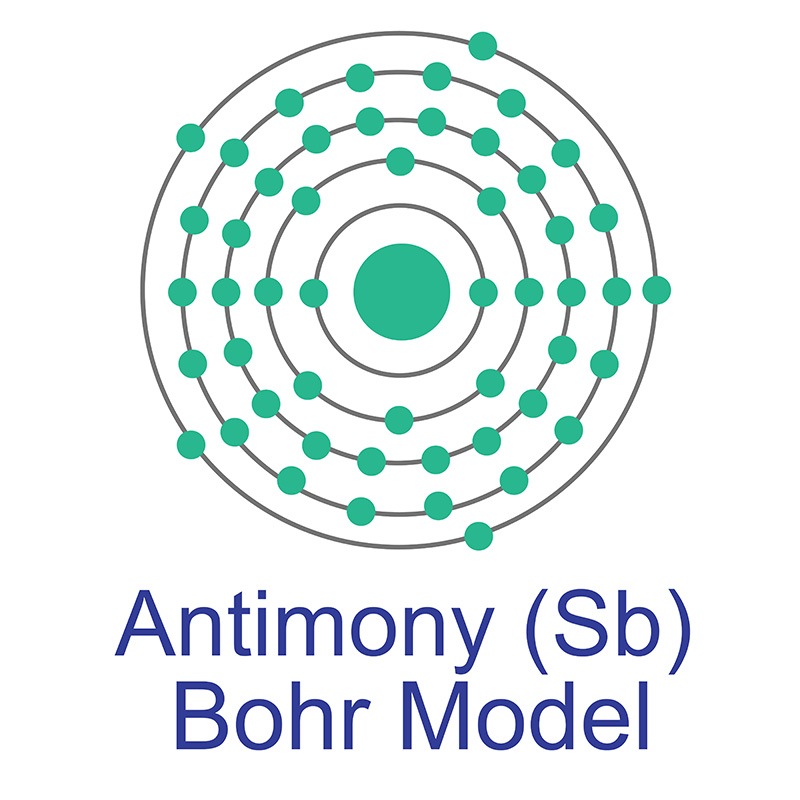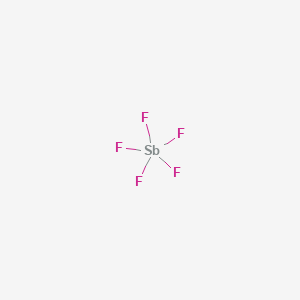SECTION 1. IDENTIFICATION
Product Name: Antimony Pentafluoride
Product Number: All applicable American Elements product codes, e.g. SB-F5-02
, SB-F5-03
, SB-F5-04
, SB-F5-05
CAS #: 7783-70-2
Relevant identified uses of the substance: Scientific research and development
Supplier details:
American Elements
10884 Weyburn Ave.
Los Angeles, CA 90024
Tel: +1 310-208-0551
Fax: +1 310-208-0351
Emergency telephone number:
Domestic, North America: +1 800-424-9300
International: +1 703-527-3887
SECTION 2. HAZARDS IDENTIFICATION
Classification of the substance or mixture
GHS Classification in accordance with 29 CFR 1910 (OSHA HCS)
Acute toxicity, Oral (Category 4), H302
Acute toxicity, Inhalation (Category 4), H332
Acute aquatic toxicity (Category 2), H401
Chronic aquatic toxicity (Category 2), H411
GHS Label elements, including precautionary statements
Pictogram
Signal word: Warning
Hazard statement(s)
H302 + H332
Harmful if swallowed or if inhaled
H411
Toxic to aquatic life with long lasting effects.
Precautionary statement(s)
P261
Avoid breathing dust/ fume/ gas/ mist/ Vapors/ spray.
P264
Wash skin thoroughly after handling.
P270
Do not eat, drink or smoke when using this product.
P271
Use only outdoors or in a well-ventilated area.
P273
Avoid release to the environment.
P301 + P312 + P330
IF SWALLOWED: Call a POISON CENTER or doctor/ physician if you feel unwell. Rinse mouth.
P304 + P340 + P312
IF INHALED: Remove victim to fresh air and keep at rest in a position comfortable for breathing. Call a POISON CENTER or doctor/ physician if you feel unwell.
P391
Collect spillage.
P501
Dispose of contents/ container to an approved waste disposal plant.
Hazards not otherwise classified (HNOC) or not covered by GHS - none.
SECTION 3. COMPOSITION/INFORMATION ON INGREDIENTS
Substances
Synonyms: Antimony pentafluoride
Formula: F5Sb
Molecular weight: 216.75 g/mol
CAS-No.: 7783-70-2
EC-No.: 232-021-8
Index-No.: 051-003-00-9
SECTION 4. FIRST AID MEASURES
Description of first aid measures
General advice
Consult a physician. Show this safety data sheet to the doctor in attendance.
Move out of dangerous area.
If inhaled
If breathed in, move person into fresh air. If not breathing, give artificial respiration. Consult a physician.
In case of skin contact
Wash off with soap and plenty of water. Consult a physician.
In case of eye contact
Flush eyes with water as a precaution.
If swallowed
Never give anything by mouth to an unconscious person. Rinse mouth with water. Consult a physician.
Most important symptoms and effects, both acute and delayed
The most important known symptoms and effects are described in the labelling (see section 2.2) and/or in section 11
Indication of any immediate medical attention and special treatment needed
No data available
SECTION 5. FIREFIGHTING MEASURES
Extinguishing media
Suitable extinguishing media
Use water spray, alcohol-resistant foam, dry chemical or carbon dioxide.
Special hazards arising from the substance or mixture
Hydrogen fluoride, Antimony oxide
Advice for firefighters
Wear self-contained breathing apparatus for firefighting if necessary.
Further information
No data available
SECTION 6. ACCIDENTAL RELEASE MEASURES
Personal precautions, protective equipment and emergency procedures
Use personal protective equipment. Avoid breathing Vapors, mist or gas. Ensure adequate ventilation.
For personal protection see section 8.
Environmental precautions
Prevent further leakage or spillage if safe to do so. Do not let product enter drains. Discharge into the environment must be avoided.
Methods and materials for containment and cleaning up
Soak up with inert absorbent material and dispose of as hazardous waste. Keep in suitable, closed containers for disposal.
Reference to other sections
For disposal see section 13.
SECTION 7. HANDLING AND STORAGE
Precautions for safe handling
Avoid contact with skin and eyes. Avoid inhalation of Vapor or mist.
For precautions see section 2.2.
Conditions for safe storage, including any incompatibilities
Keep container tightly closed in a dry and well-ventilated place.
Containers which are opened must be carefully resealed and kept upright to prevent leakage.
Reacts violently with water.
Storage class (TRGS 510): Non Combustible Liquids
Specific end use(s)
Apart from the uses mentioned in section 1.2 no other specific uses are stipulated
SECTION 8. EXPOSURE CONTROLS/PERSONAL PROTECTION
Exposure controls
Appropriate engineering controls
Handle in accordance with good industrial hygiene and safety practice. Wash hands before breaks and at the end of workday.
Personal protective equipment
Eye/face protection
Face shield and safety glasses Use equipment for eye protection tested and approved under appropriate government standards such as NIOSH (US) or EN 166(EU).
Skin protection
Handle with gloves. Gloves must be inspected prior to use. Use proper glove removal technique (without touching glove's outer surface) to avoid skin contact with this product. Dispose of contaminated gloves after use in accordance with applicable laws and good laboratory practices. Wash and dry hands.
Body Protection
Complete suit protecting against chemicals, The type of protective equipment must be selected according to the concentration and amount of the dangerous substance at the specific workplace.
Respiratory protection
Where risk assessment shows air-purifying respirators are appropriate use a full-face respirator with multi-purpose combination (US) or type ABEK (EN 14387) respirator cartridges as a backup to engineering controls.
If the respirator is the sole means of protection, use a full-face supplied air respirator. Use respirators and components tested and approved under appropriate government standards such as NIOSH (US) or CEN (EU).
Control of environmental exposure
Prevent further leakage or spillage if safe to do so. Do not let product enter drains. Discharge into the environment must be avoided.
SECTION 9. PHYSICAL AND CHEMICAL PROPERTIES
Information on basic physical and chemical properties
Appearance
Form: liquid
Colour: colourless
Odor: No data available
Odor Threshold: No data available
pH: No data available
Melting point/freezing point
Melting point/range: 7 °C (45 °F) - lit.
Initial boiling point and boiling range: 148 - 150 °C (298 - 302 °F) - lit.
Flash point: N/A
Evaporation rate: No data available
Flammability (solid, gas): No data available
Upper/lower flammability or explosive limits: No data available
Vapor pressure: 13 hPa (10 mmHg) at 25 °C (77 °F)
Vapor density: 7.48 - (Air = 1.0)
Relative density: 2.993 g/cm3 at 25 °C (77 °F)
Water solubility: No data available
Partition coefficient: n-octanol/water: No data available
Auto-ignition temperature: No data available
Decomposition temperature: No data available
Viscosity: No data available
Explosive properties: No data available
Oxidizing properties: No data available
Other safety information
Relative Vapor density: 7.48 - (Air = 1.0)
SECTION 10. STABILITY AND REACTIVITY
Reactivity
No data available
Chemical stability
Stable under recommended storage conditions.
Possibility of hazardous reactions
No data available
Conditions to avoid
Do not allow water to enter container because of violent reaction.
Incompatible materials
Strong oxidizing agents
Strong bases, Water, Highly toxic fumes
Hazardous decomposition products
Other decomposition products - No data available
In the event of fire: see section 5
SECTION 11. TOXICOLOGICAL INFORMATION
Information on toxicological effects
Acute toxicity
No data available
Inhalation: No data available
Dermal: No data available
No data available
Skin corrosion/irritation: No data available
Serious eye damage/eye irritation: No data available
Respiratory or skin sensitisation: No data available
Germ cell mutagenicity: No data available
Carcinogenicity
IARC:
3 - Group 3: Not classifiable as to its carcinogenicity to humans (Antimony(V) fluoride)
NTP:
No component of this product present at levels greater than or equal to 0.1% is identified as a
known or anticipated carcinogen by NTP.
OSHA:
No component of this product present at levels greater than or equal to 0.1% is identified as a
carcinogen or potential carcinogen by OSHA.
Reproductive toxicity
No data available
No data available
Specific target organ toxicity - single exposure
No data available
Specific target organ toxicity - repeated exposure
No data available
Aspiration hazard
No data available
Additional Information
RTECS: Not available
Salivation, Nausea, Abdominal pain, Vomiting, Fever, Rapid respiration, Fluoride ion can reduce serum calcium levels possibly causing fatal hypocalcemia., Material is extremely destructive to tissue of the mucous membranes and upper respiratory tract, eyes, and skin spasm, inflammation and edema of the larynx, spasm, inflammation and edema of the bronchi, pneumonitis, pulmonary edema, burning sensation
Stomach - Irregularities - Based on Human Evidence
Stomach - Irregularities - Based on Human Evidence
SECTION 12. ECOLOGICAL INFORMATION
Toxicity
No data available
Persistence and degradability
No data available
Bioaccumulative potential
No data available
Mobility in soil
No data available
Results of PBT and vPvB assessment
PBT/vPvB assessment not available as chemical safety assessment not required/not conducted
Other adverse effects
An environmental hazard cannot be excluded in the event of unprofessional handling or disposal.
Toxic to aquatic life with long lasting effects.
SECTION 13. DISPOSAL CONSIDERATIONS
Waste treatment methods
Product
Offer surplus and non-recyclable solutions to a licensed disposal company.
Contact a licensed professional waste disposal service to dispose of this material.
Contaminated packaging
Dispose of as unused product.
SECTION 14. TRANSPORT INFORMATION
DOT (US)
UN number: 1732
Class: 8 (6.1)
Packing group: II
Proper shipping name: Antimony pentafluoride
Reportable Quantity (RQ):
Poison Inhalation Hazard: No
IMDG
UN number: 1732
Class: 8 (6.1)
Packing group: II
EMS-No: F-A, S-B
Proper shipping name: ANTIMONY PENTAFLUORIDE
Marine pollutant: yes
IATA
UN number:1732
Class: 8 (6.1)
Packing group: II
Proper shipping name: Antimony pentafluoride
IATA Passenger: Not permitted for transport
SECTION 15. REGULATORY INFORMATION
SARA 302
Components
The following components are subject to reporting levels established by SARA Title III, Section 302:
Antimony(V) fluoride
CAS-No.: 7783-70-2
Revision Date: 2007-07-01
SARA 313
Components
The following components are subject to reporting levels established by SARA Title III, Section 313:
Antimony(V) fluoride
CAS-No.: 7783-70-2
Revision Date: 2007-07-01
SARA 311/312
Hazards
Acute Health Hazard, Chronic Health Hazard
Massachusetts Right To Know Components
Antimony(V) fluoride
CAS-No.: 7783-70-2
Revision Date: 2007-07-01
Pennsylvania Right To Know Components
Antimony(V) fluoride
CAS-No.: 7783-70-2
Revision Date: 2007-07-01
New Jersey Right To Know Components
Antimony(V) fluoride
CAS-No.: 7783-70-2
Revision Date: 2007-07-01
California Prop. 65 Components
This product does not contain any chemicals known to State of California to cause cancer, birth defects, or any other reproductive harm.
SECTION 16. OTHER INFORMATION
Safety Data Sheet according to Regulation (EC) No. 1907/2006 (REACH). The above information is believed to be correct but does not purport to be all inclusive and shall be used only as a guide. The information in this document is based on the present state of our knowledge and is applicable to the product with regard to appropriate safety precautions. It does not represent any guarantee of the properties of the product. American Elements shall not be held liable for any damage resulting from handling or from contact with the above product. See reverse side of invoice or packing slip for additional terms and conditions of sale. COPYRIGHT 1997-2022 AMERICAN ELEMENTS. LICENSED GRANTED TO MAKE UNLIMITED PAPER COPIES FOR INTERNAL USE ONLY.

 The most common source of antimony is the
The most common source of antimony is the 
